EQ3 CC-RT-BLE Handleiding
EQ3
Thermostaat
CC-RT-BLE
Bekijk gratis de handleiding van EQ3 CC-RT-BLE (2 pagina’s), behorend tot de categorie Thermostaat. Deze gids werd als nuttig beoordeeld door 61 mensen en kreeg gemiddeld 4.4 sterren uit 31 reviews. Heb je een vraag over EQ3 CC-RT-BLE of wil je andere gebruikers van dit product iets vragen? Stel een vraag
Pagina 1/2

Bedienungsanleitung
eQ-3 BLUETOOTH® Smart Heizkörperthermostat
1. Ausgabe Deutsch 04/2015
Dokumentation © 2015 eQ-3 AG, Deutschland.
Alle Rechte vorbehalten.
CC-RT-BLE, V1.2, Art-Nr. 141814
1. Hinweise zu dieser Anleitung
Lesen Sie diese Anleitung vollständig und sorgfältig, bevor Sie das Gerät in Betrieb
nehmen. Sie enthält zahlreiche Hinweise zum bestimmungsgemäßen Einsatz des
Gerätes. Beachten Sie insbesondere die Sicherheitshinweise. Bewahren Sie die
Anleitung zum späteren Nachschlagen auf. Wenn Sie das Gerät anderen Personen
zur Nutzung überlassen, übergeben Sie bitte auch diese Anleitung.
Benutzte Symbole:
Achtung! Hier wird auf eine Gefahr hingewiesen.
Hinweis. Dieser Abschnitt enthält zusätzliche wichtige Informationen.
2. Lieferumfang
1x Heizkörperthermostat, 1x Adapter Danfoss RA, 1x Stützring, 1x Mutter M4,
1x Zylinderkopfschraube M4 x 12 mm, 2x 1,5 V Mignon/LR6/AA, 3x Bedienungsanlei-
tung in Deutsch/Englisch, Französisch/Niederländisch, Polnisch/Italienisch
3. Geräteübersicht
A
C
D
B
E
F
G
H
AÜberwurfmutter zur Montage am
Heizungsventil
BEingestellte Schaltzeiträume im Wochen-
programm
CAbsenk-/Komfort-Temperatur ( ), Fens-
ter-auf-Funktion ( ), Manueller Betrieb
(Manu), Automatikbetrieb (Auto)
DUrlaubsfunktion ( ), Wochentag, Batte-
rie-leer-Symbol ( )
E Mode-/Menu-Taste: Wechsel zwischen
Automatikbetrieb, manuellen Betrieb und
Urlaubsfunktion (Taste kurz drücken);
Öffnen des Kongurationsmenüs (Taste
mind. 3 Sekunden drücken)
FStellrad: Einstellungen vornehmen, z. B.
Temperatur (durch Drehen des Stellrads),
Aktivierung der Boost-Funktion und Be-
stätigen bzw. Speichern von Einstellungen
im Menü (kurzes Drücken des Stellrads)
G-Taste: Umschalten zwischen Absenk-/
Komfort-Temperatur
H
Temperaturanzeige, Zeit-/Datumsanzeige,
Menüpunkte
, Funktionen
4. Allgemeine Funktion
Der elektrische BLUETOOTH® Smart Heizkörperthermostat ermöglicht eine zeit-
gesteuerte Regulierung der Raumtemperatur über eine intuitiv bedienbare App.
Die kostenlose App „calor BT“ ist für iOS- und Android-Smartphones verfügbar. Der
Heizkörperthermostat dient zur Regulierung einzelner Heizkörper bzw. der Raum-
temperatur.
Durch vorprogrammierte oder individuelle Heiz- und Absenkphasen kann die ge-
wünschte Temperatur komfortabel eingestellt werden.
Der Heizkörperthermostat passt auf alle gängigen Heizkörperventile und ist einfach
zu montieren - ohne Ablassen von Heizungswasser oder einen Eingriff in das Hei-
zungssystem. Die Boost-Funktion ermöglicht ein schnelles, kurzzeitiges Aufheizen
des Heizkörpers durch vollständige Öffnung des Ventils. Durch eine automatische
„Fenster-auf-Erkennung“ wird zusätzlich Energie während des Lüftens gespart.
5. Bestimmungsgemäßer Einsatz
Der Heizkörperthermostat dient zum Regulieren eines gängigen Heizkörperventils.
Betreiben Sie das Gerät nur in Innenräumen und vermeiden Sie den Einuss von
Feuchtigkeit, Staub sowie Sonnen- oder Wärmebestrahlung. Jeder andere Einsatz
als der in dieser Bedienungsanleitung beschriebene ist nicht bestimmungsgemäß
und führt zu Garantie- und Haftungsausschluss. Dies gilt auch für Umbauten und
Veränderungen. Das Gerät ist ausschließlich für den privaten Gebrauch gedacht.
Hiermit erklärt die eQ-3 AG, dass sich dieses Gerät in Übereinstimmung mit den
grundlegenden Anforderungen und den anderen relevanten Vorschriften der Richt-
linie 1999/5/EG bendet. Die vollständige Konformitätserklärung nden Sie unter
www.eQ-3.de.
6. Sicherheitshinweise
Das Gerät ist kein Spielzeug; erlauben Sie Kindern nicht damit zu spielen.
Lassen Sie Verpackungsmaterial nicht achtlos liegen. Dies kann für Kinder zu
einem gefährlichen Spielzeug werden.
Öffnen Sie das Gerät nicht, es enthält keine durch den Anwender zu warten-
den Teile. Im Fehlerfall lassen Sie das Gerät von einer Fachkraft prüfen.
7. Entsorgungshinweise
Gerät nicht im Hausmüll entsorgen!
Elektronische Geräte sind entsprechend der Richtlinie über Elektro- und
Elektronik-Altgeräte über die örtlichen Sammelstellen für Elektronik-Altgerä-
te zu entsorgen!
Das CE-Zeichen ist ein Freiverkehrszeichen, das sich ausschließlich an die
Behörden wendet und keine Zusicherung von Eigenschaften beinhaltet.
Verbrauchte Batterien gehören nicht in den Hausmüll! Entsorgen Sie
diese in Ihrer örtlichen Batteriesammelstelle!
8. Batterien einlegen (wechseln)
Im Auslieferungszustand sind die Batterien bereits eingelegt. Entfernen Sie
einfach den Isolierstreifen.
Um die Batterien zu wechseln, gehen Sie wie folgt vor:
• Drücken Sie den Batteriefachdeckel an den Einkerbungen
auf beiden Seiten mit den Fingern ein und ziehen Sie ihn
nach unten ab.
• Legen Sie 2 neue Batterien vom Typ LR6/Mignon/AA
(1,5 V) polungsrichtig in das Batteriefach ein.
• Setzen Sie den Batteriefachdeckel wieder auf und rasten
Sie ihn ein.
Die Lebensdauer neuer Alkaline Batterien beträgt ca. 2 Jahre. Ein Batteriesym-
bol ( ) im Display weist darauf hin, dass die Batterien auszutauschen sind.
Nach Entnahme der leeren Batterien sollte bis zum Einlegen der neuen Batte-
rien ca. 1 Minute gewartet werden. Ein Betrieb mit Akkus ist nicht möglich.
Normale Batterien dürfen niemals aufgeladen werden. Es besteht Explosi-
onsgefahr. Batterien nicht ins Feuer werfen! Batterien nicht kurzschließen!
9. Datum und Uhrzeit einstellen
Wenn Batterien eingelegt wurden, werden nach kurzer Anzeige der Firmware-Versi-
onsnummer und kurzem Motorlauf („InS“) automatisch Datum und Uhrzeit abgefragt.
• Stellen Sie Jahr, Monat, Tag, Stunde und Minute durch Drehen des Stellrads ein
und bestätigen Sie durch kurzes Drücken des Stellrads (F).
Datum und Uhrzeit können Sie auch später im Menü unter „dAt“ einstellen.
Während der Eingabe von Datum und Uhrzeit fährt der Motor den Steuerstift be-
reits zurück.
• Die Anzeige „InS“ mit drehendem „ “ weist darauf hin, dass der Motor noch zu-
rückfährt. Sobald der Heizkörperthermostat am Ventil montiert werden kann, steht
nur „InS“ im Display.
Das Wochenprogramm und andere Einstellungen können vor der Montage an-
gepasst werden. Drücken Sie dazu die Mode/Menu-Taste, während in der An-
zeige „InS“ steht. Mehr Details nden Sie ab Abschnitt „13. Steuerung und
Konguration“.
• Nach abgeschlossener Programmierung steht erneut „InS“ im Display und die
Montage kann erfolgen.
10. Montage am Heizkörper
Die Montage des Heizkörperthermostaten ist einfach und kann ohne Ablassen von
Heizungswasser oder Eingriff in das Heizungssystem erfolgen. Spezialwerkzeug
oder ein Abschalten der Heizung sind nicht erforderlich. Die am Heizkörperthermo-
stat angebrachte Überwurfmutter ist universell einsetzbar und ohne Zubehör pas-
send für alle gängigen Ventile mit dem Gewindemaß M30 x 1,5 mm.
• Drehen Sie den Thermostatkopf auf den Maximal-
wert (gegen den Uhrzeigersinn). Der Thermostat-
kopf drückt jetzt nicht mehr auf die Ventilspindel
und kann so leichter demontiert werden.
• Entfernen Sie den alten Thermostatkopf. Setzen
Sie bei Bedarf den beiliegenden Stützring oder
Adapter auf.
• Montieren Sie den Heizkörperthermostat auf das
Ventil.
10.1 Stützring und Adapter für Danfoss
Bei Bedarf legen Sie den beiliegenden Stützring (I) vor der Montage in den Flansch
des Gerätes ein, um einen festeren Sitz am Ventil zu ermöglichen.
Zur Montage auf Danfoss RA-Ventile kann der beiliegende Adapter verwendet wer-
den. Die Ventilkörper von Danfoss weisen umlaufend längliche Einkerbungen (K)
auf, die auch einen besseren Sitz des Adapters nach dem Aufrasten gewährleisten.
Achten Sie bei der Montage darauf, dass die Zapfen im Inneren des Adapters
(J) eine deckungsgleiche Position zu den Einkerbungen (K) am Ventil haben.
Rasten Sie den Adapter vollständig auf.
Achten Sie bei der Montage darauf, sich nicht die Finger zwischen den Adap-
terhälften einzuklemmen!
I
11. Adaptierfahrt
Nach dem Einlegen der Batterien und der Montage am Ventil wird zur Anpassung
an das Ventil eine Adaptierfahrt („AdA“) durchgeführt.
• Sobald der Heizkörperthermostat auf dem Ventil montiert wurde, drücken Sie kurz
auf das Stellrad, wenn im Display „InS“ steht.
Während der Adaptierfahrt werden „AdA“ und das Aktivitätssymbol ( ) im Display
angezeigt. In der Zwischenzeit ist keine Bedienung möglich.
Wurde die Adaptierfahrt vor der Montage eingeleitet, drücken Sie kurz auf das
Stellrad und der Motor fährt zurück zur Position „InS“. Wird eine Fehlermeldung
(F1, F2, F3) angezeigt, fährt der Motor ebenfalls zurück zur Position „InS“.
12. Display-Inhalt im Normalbetrieb
Im Normalbetrieb werden Schaltzeiträume, Betriebsmodus,
Soll-Temperatur und Wochentag angezeigt.
Die Balken für Schaltzeiträume des Wochenprogramms werden
für jedes zweite Zeitintervall angezeigt.
13. SteuerungundKonguration
Nachdem Sie den Heizkörperthermostat montiert und in Betrieb genommen haben,
kann das Gerät individuell gesteuert und konguriert werden. Die Steuerung und
Konguration kann entweder per BLUETOOTH
® über die App „calor BT“ oder di-
rekt am Gerät erfolgen.
13.1 SteuerungundKongurationüberApp
Um das Gerät per App zu steuern, gehen Sie wie folgt vor:
• Laden Sie die App „calor BT“ aus dem App Store für iOS oder Android herunter
und installieren Sie diese auf Ihrem Smartphone.
• Folgen Sie den Anweisungen in der App.
Sie können den Heizkörperthermostat anschließend über die App steuern und kon-
gurieren.
13.2 SteuerungundKongurationdirektamGerät
Um die Steuerung und Kongurationen direkt am Gerät vorzunehmen, gehen Sie
wie in den nachfolgend beschriebenen Abschnitten vor.
13.2.1 Wochenprogramm (Pro)
Im Wochenprogramm lassen sich für jeden Wochentag separat bis zu 3 Heizpha-
sen (7 Schaltzeitpunkte) einstellen. Die Programmierung erfolgt für die ausgewähl-
ten Tage, wobei für einen Zeitraum von 00:00 bis 23:59 Uhr Temperaturen hinter-
legt werden können.
• Drücken Sie die Mode-/Menu-Taste mindestens 3 Sekunden. Im Display erscheint
„Pro“. Bestätigen Sie durch kurzes Drücken des Stellrads.
• Im Display erscheint „dAy“. Mit dem Stellrad sind einzelne Wochentage, alle Werk-
tage, das Wochenende oder die gesamte Woche auswählbar.
• Bestätigen Sie durch kurzes Drücken des Stellrads.
• Der erste Schaltzeitpunkt wird angezeigt (0:00). Dieser kann nicht verändert wer-
den. Die Heizzeiten werden als Balken angezeigt.
• Bestätigen Sie durch kurzes Drücken des Stellrads.
• Stellen Sie die Temperatur ein, die ab 0:00 Uhr gewünscht ist.
• Bestätigen Sie durch kurzes Drücken des Stellrads.
• Der nächste Schaltzeitpunkt wird angezeigt. Diesen können Sie individuell anpassen.
• Stellen Sie anschließend die Temperatur ein, die ab der gewünschten Uhrzeit
vorherrschen soll.
• Diesen Vorgang können Sie wiederholen, bis die weiteren gewünschten Tempe-
raturen für den Zeitraum von 0:00 bis 23:59 Uhr hinterlegt sind.
• Sind alle 7 Schaltzeitpunkte belegt, wird 23:59 Uhr als Endzeitpunkt zum Bestä-
tigen angezeigt.
Im Auto-Modus kann die Temperatur jederzeit auch über das Stellrad verän-
dert werden. Die geänderte Temperatur bleibt dann bis zum nächsten Schalt-
zeitpunkt erhalten.
13.2.2 Datum und Uhrzeit einstellen (dAt)
Über das Menü können jederzeit das Datum und die Uhrzeit angepasst werden.
• Drücken Sie die Mode-/Menu-Taste mindestens 3 Sekunden.
• Wählen Sie mit dem Stellrad den Menüpunkt „dAT“ aus.
• Stellen Sie Jahr, Monat, Tag, Stunde und Minute durch Drehen des Stellrads ein
und bestätigen Sie durch kurzes Drücken des Stellrads.
13.2.3 Umschalten Sommer-/Winterzeit (dSt)
Für den Heizkörperthermostat kann eine automatische Umschaltung zwischen Som-
mer- und Winterzeit aktiviert bzw. deaktiviert werden. Werkseitig ist die automati-
sche Umschaltung aktiviert.
• Drücken Sie die Mode-/Menu-Taste mindestens 3 Sekunden.
• Wählen Sie mit dem Stellrad den Menüpunkt „dSt“ aus.
• Bestätigen Sie die Auswahl durch kurzes Drücken des Stellrads.
• Im Display erscheint „OFF“, wenn die Funktion deaktiviert werden soll oder „On“,
wenn die Funktion aktiviert werden soll.
• Bestätigen Sie Ihre Auswahl durch kurzes Drücken des Stellrads.
13.2.4 Fenster-auf-Funktion (AEr)
Der Heizkörperthermostat erkennt bei einer stark absinkenden Temperatur automa-
tisch, dass ein Raum gelüftet wird. Um Heizkosten zu sparen, wird dann die Tempe-
ratur für einen bestimmten Zeitraum herunter geregelt (werkseitig 15 Minuten). Wäh-
renddessen wird im Display das Fenster-auf-Symbol ( ) angezeigt.
• Drücken Sie die Mode-/Menu-Taste mindestens 3 Sekunden.
• Wählen Sie mit dem Stellrad den Menüpunkt „AEr“ und bestätigen Sie durch kur-
zes Drücken des Stellrads.
• Die Temperatur und die Zeit lassen sich mit dem Stellrad einstellen. Mit der Zeit-
auswahl „0“ lässt sich die Funktion deaktivieren.
13.2.5 Offset-Temperatur einstellen (tOF)
Da die Temperatur am Heizkörper gemessen wird, kann es an einer anderen Stelle
im Raum kälter oder wärmer sein. Um dies anzugleichen, kann ein Temperatur-Off-
set von bis zu ±3.5 °C eingestellt werden. Werden z. B. 18 °C anstatt eingestellter
20 °C im Raum erreicht, ist ein Offset von -2.0 °C einzustellen.
• Drücken Sie die Mode-/Menu-Taste mindestens 3 Sekunden.
• Wählen Sie mit dem Stellrad den Menüpunkt „tOF“ aus und bestätigen Sie durch
kurzes Drücken des Stellrads.
• Drehen Sie das Stellrad so lange, bis die gewünschte Temperatur erscheint.
• Bestätigen Sie durch kurzes Drücken des Stellrads.
13.2.6 BLUETOOTH® aktivieren/deaktivieren (bLE)
Die BLUETOOTH® Funktion des Heizkörperthermostaten kann manuell aktiviert
bzw. deaktiviert werden.
• Drücken Sie die Mode-/Menu-Taste mindestens 3 Sekunden.
• Wählen Sie mit dem Stellrad den Menüpunkt „bLE“ aus und bestätigen Sie durch
kurzes Drücken des Stellrads.
• Im Display erscheint „OFF“, wenn die Funktion deaktiviert werden soll oder „On“,
wenn die Funktion aktiviert werden soll.
• Bestätigen Sie durch kurzes Drücken des Stellrads.
13.2.7 Werkseinstellungen wiederherstellen (rES)
Die Werkseinstellungen des Heizkörperthermostaten können manuell wieder herge-
stellt werden. Dabei gehen alle vorgenommenen Einstellungen verloren.
• Drücken Sie die Mode-/Menu-Taste mindestens 3 Sekunden.
• Wählen Sie mit dem Stellrad den Menüpunkt „rES“ aus und bestätigen Sie durch
kurzes Drücken des Stellrads.
• Anschließend erscheint „COnF“ im Display.
• Bestätigen Sie durch kurzes Drücken des Stellrads.
13.2.8 Boost-Funktion
Kommen Sie z. B. früher nach Hause und möchten es schnell warm haben, hilft Ih-
nen die Boost-Funktion. Bei Aktivierung der Boost-Funktion wird das Heizungsventil
sofort für 5 Minuten auf 80 % geöffnet. Die Erwärmung eines Raumes dauert zwar
länger als 5 Minuten, die vom Heizkörper abgegebene Wärme kann dennoch sofort
wahrgenommen werden.
• Drücken Sie kurz das Stellrad zum Aktivieren der Boost-Funktion.
• Die verbleibende Funktionsdauer wird im Sekundentakt heruntergezählt („b300“
bis „b000“).
• Nach Ablauf dieser 5 Minuten wechselt der Heizkörperthermostat in den vorher
aktiven Modus (Auto/Manu) mit der vorher eingestellten Temperatur.
• Die Funktion lässt sich jederzeit vorzeitig durch Betätigen des Stellrads deaktivieren.
Die Boost-Funktion hat keinen unmittelbaren Effekt, wenn der Heizkörper ver-
deckt ist (z. B. durch ein Sofa). Die Fenster-auf-Funktion ist während der Boost-
Funktion deaktiviert.
13.2.9 Urlaubsfunktion einstellen
Die Urlaubsfunktion kann genutzt werden, wenn für einen bestimmten Zeitraum eine
feste Temperatur gehalten werden soll (z. B. während eines Urlaubs oder einer Party).
• Drücken Sie die Mode-/Menu-Taste so oft kurz, bis im Display das Koffersymbol
( ) erscheint.
• Stellen Sie über das Stellrad die Uhrzeit ein, bis zu der die Temperatur gehalten
werden soll und bestätigen Sie durch kurzes Drücken des Stellrads.
• Stellen Sie das Datum ein und bestätigen Sie durch kurzes Drücken des Stellrads.
• Stellen Sie die Temperatur ein und bestätigen Sie durch kurzes Drücken des
Stellrads.
Die eingestellte Temperatur bleibt bis zum vorgegebenen Zeitpunkt bestehen. Da-
nach wechselt der Heizkörperthermostat in den Auto-Modus.
13.2.10 Komfort- und Absenk-Temperatur
Über die Taste Komfort-/Absenk-Temperatur ( ) kann zwischen diesen beiden
Temperaturen gewechselt werden. Werkseitig liegen diese bei 21.0 °C (Komfort-
Temperatur) und 17.0 °C (Absenk-Temperatur).
• Halten Sie die Komfort-/Absenktaste ( ) für mindestens 3 Sekunden gedrückt.
• Im Display erscheinen das Sonnensymbol ( ) und die aktuell hinterlegte Kom-
fort-Temperatur.
• Verändern Sie die Temperatur mit dem Stellrad und bestätigen Sie durch kurzes
Drücken des Stellrads.
• Im Display erscheinen das Mondsymbol ( ) und die Absenk-Temperatur.
• Verändern Sie die Temperatur mit dem Stellrad und bestätigen Sie durch kurzes
Drücken des Stellrads.
Auch im Auto-Modus kann die Temperatur über die Taste jederzeit geändert wer-
den. Diese bleibt dann bis zum nächsten Schaltzeitpunkt des Programms erhalten.
13.2.11 Heizpause aktivieren (Batterieschonung)
Ist die Heizung im Sommer abgeschaltet, können die Batterien geschont werden.
Dazu wird das Ventil ganz geöffnet. Der Verkalkungsschutz wird weiter durchgeführt.
Um Batterien zu schonen, kann zudem die BLUETOOTH
® Funktion deaktiviert
werden (siehe Abschnitt „13.2.6 Bluetooth® aktivieren/deaktivieren (bLE)“ auf
Seite 1).
Zum Aktivieren der Heizpause gehen Sie wie folgt vor:
• Drehen Sie das Stellrad im manuellen Betrieb (Manu) so lange nach rechts, bis
im Display „On“ erscheint.
• Zum Beenden verlassen Sie den manuellen Betrieb (Manu) oder drehen Sie das
Stellrad nach links.
13.2.12 Frostschutzbetrieb einstellen
Wenn ein Raum nicht geheizt werden soll, kann das Ventil geschlossen werden.
Nur bei Frostgefahr wird das Ventil geöffnet. Der Verkalkungsschutz wird weiter
durchgeführt.
• Drehen Sie das Stellrad im manuellen Betrieb (Manu) so lange nach links, bis im
Display „OFF“ erscheint.
• Zum Beenden verlassen Sie den manuellen Betrieb (Manu) oder drehen Sie das
Stellrad nach rechts.
13.2.13 Kindersicherung / Bediensperre
Die Bedienung des Gerätes kann gesperrt werden.
• Zur Aktivierung/Deaktivierung der Bediensperre, drücken Sie die Tasten Mode-/
Menu und kurz gleichzeitig.
• Nach erfolgreicher Aktivierung erscheint „LOC“ im Display.
• Zur Deaktivierung der Bediensperre, drücken Sie erneut beide Tasten.
14. Fehlerbehebung und Wartung
Fehlercode im Display Problem Behebung
Batteriesymbol ( ) Batterieleistung zu gering Batterien austauschen
F1 Ventilantrieb schwergängig Installation prüfen,
Heizungsventil überprüfen
F2 Stellbereich zu groß Befestigung des Heizkörper-
thermostaten überprüfen
F3 Stellbereich zu klein Heizungsventil überprüfen
Zum Schutz vor Ventilverkalkung führt der Heizkörperthermostat einmal wö-
chentlich am Samstag um 12:00 Uhr eine Entkalkungsfahrt durch. Dabei er-
scheint „CAL“ im Display.
15. Technische Eigenschaften
Geräte-Kurzbezeichnung: CC-RT-BLE
Versorgungsspannung: 2x 1,5 V LR6/Mignon/AA
Stromaufnahme: 100 mA max.
Batterielebensdauer: 2 Jahre (typ.)
Schutzart: IP20
Verschmutzungsgrad: 2
Umgebungstemperatur: 5 bis 35 °C
Oberächentemperatur: 90 °C (am Heizkörper)
Display: LC-Display
Anschluss: M30 x 1,5 mm
Wirkungsweise: Typ 1
Linearer Hub: 4,3 mm
Abmessungen (B x H x T): 55 x 60 x 102 mm
Gewicht: 162 g (inkl. Batterien)
Funkfrequenz: 2,402 GHz - 2,480 GHz
Freifeldreichweite: 10 m (typ.)
Technische Änderungen sind vorbehalten.
The BLUETOOTH® word mark and logos are registered trademarks owned
by Bluetooth SIG, Inc. and any use of such marks by eQ-3 AG is under licen-
se. Other trademarks and trade names are those of their respective owners.
K
J
Bevollmächtigter des Herstellers:
Manufacturer’s authorised representative:
eQ-3 AG
Maiburger Straße 29
26789 Leer / GERMANY
www.eQ-3.de

Operating manual
eQ-3 BLUETOOTH
®
Smart Radiator Thermostat
1st English edition 04/2015
Documentation © 2015 eQ-3 AG, Germany
All rights reserved. Translation from the original version in German.
CC-RT-BLE, V1.2, 141814
1. Information about this manual
Please read this manual completely and carefully before starting to use the device.
The manual contains important information about the intended use of the device.
Especially observe the safety notes. Keep the manual for later consultation. If you
hand over the device to other persons for use, please hand over this manual as well.
Symbols used:
Attention! This indicates a hazard.
Note. This section contains important additional information.
2. Package contents
1x radiator thermostat, 1x adapter Danfoss RA, 1x support ring, 1x nut M4,
1x cylinder head screw M4 x 12 mm, 2x 1.5 V mignon/LR6/AA, 3x operating manual in
German/English, French/Dutch and Polish/Italian
3. Device overview
A
C
D
B
E
F
G
H
AUnion nut for tting on the heating valve
BDened switching time periods in the
week program
CEco/comfort temperature ( ), open-win-
dow function ( ), manual mode (Manu),
automatic mode ( )Auto
DHoliday function ( ), weekday, empty
battery symbol ( )
EMode/Menu button: Switch between auto
mode, manu mode and holiday function
(press button shortly); conguration menu
(press button for at least 3 seconds)
FControl wheel: Change settings, e.g. tem-
perature (turn the control wheel), activate
the boost function and conrm/save set-
tings in the menu (press control wheel
shortly)
G button: Switch between eco and com-
fort temperature
H
Temperature display, time/date display,
menu items
, functions
4. Function
The electric BLUETOOTH® Smart Radiator Thermostat offers individual control of
the room temperature from a user-friendly and intuitive app.
The app “calor BT” is available for free for iOS and Android smartphones. The radia-
tor thermostat enables the regulation of single radiators or the room temperature.
Thanks to pre-programmed or individually tailored heating and cooling phases, the
desired temperature can be comfortably adjusted.
The radiator thermostat ts to all common radiator valves and is easy to mount -
without having to drain any water or intervene in the heating system. With the boost
function, cool rooms can be heated within short by opening the heating valve fully.
Thanks to the automatic “open window detection”, additional energy can be saved
during ventilation.
5. Intended use
The radiator thermostat is used to control a conventional radiator valve. Only operate
the device in inside rooms and avoid the inuence of moisture, dust and sunlight or
external heat radiation. Using the device for any purpose other than that described
in this operating manual does not fall within the scope of intended use and shall in-
validate any warranty or liability. This also applies to any conversion or modication
work. The device is intended for private use only.
eQ-3 AG hereby declares that this device complies with the essential requirements
and other relevant regulations of Directive 1999/5/EC. You can nd the full declara-
tion of conformity at www.eQ-3.de.
6. Safety instructions
The device is not a toy; do not allow children to play with it.
Do not leave packaging material lying around. It can be dangerous in the hands
of a child.
Do not open the device: it does not contain any components that need to be
serviced by the user. In the event of an error, please have the device checked
by an expert.
7. Disposal instructions
Do not dispose of the device with regular domestic waste!
Electronic equipment must be disposed of at local collection points for waste
electronic equipment in compliance with the Waste Electrical and Electronic
Equipment Directive.
The CE sign is a free trading sign addressed exclusively to the authorities and
does not include any warranty of any properties.
Used batteries should not be disposed of with regular domestic waste!
Instead, take them to your local battery disposal point.
8. Inserting (replacing) batteries
In the initial state, the batteries are already inserted. Simply remove the insu-
lation strip.
To replace the batteries, please proceed as follows:
• Press the battery compartment cover on both sides with
your ngers and remove the cover by pushing it downwards.
• Insert 2 new LR6/mignon/AA (1.5 V) batteries in the battery
compartment, making sure they are the right way round.
• Reattach the battery compartment cover and latch it into
place.
The service life of new alkaline batteries is approximately
2 years. A battery symbol ( ) on the display indicates that the batteries need
to be replaced. After removing the empty batteries, wait approx. 1 minute before
inserting the new ones. Operation with rechargeable batteries is not possible.
Never recharge standard batteries. Doing so will present a risk of explosion.
Do not throw the batteries into a re. Do not short-circuit batteries.
9. Set date and time
After inserting batteries, the date and time is automatically requested after a brief
display of the rmware version number and short motor run (“InS”).
• Set the year, month, day, hour and minute with the control wheel and conrm by
pressing the control wheel shortly (F).
You can adjust the time and date in the menu under “dAt”.
The motor moves the control pin backwards during the setting of date and time.
• If “InS” and the rotating activity symbol “ ” are displayed, the motor still reverses.
When only “InS” is shown in the display, the radiator thermostat can be installed
on the valve.
The week program and other settings can be adjusted before installation. Press
the Mode/Menu button for this, while “InS” is shown in the display. You will nd
further information in chapter “13. Operation and conguration”.
• After the programming has been completed, “InS” is shown again in the display
and installation can take place.
10. Installation on the radiator
The radiator thermostat is easy to install and can be done without draining heating
water or intervening in the heating system. No special tools are required, nor does
the heating have to be switched off. The union nut attached to the radiator thermo-
stat can be used universally and without accessories for valves of the most popular
manufacturers with a thread size of M30 x 1.5 mm.
• Rotate the thermostat dial to the maximum value
(anti-clockwise). The thermostat dial then no longer
presses against the valve spindle, making it eas-
ier to remove.
• Remove the mechanical thermostat head. If re-
quired, place the supplied support ring or adapt-
er rst.
• Attach the radiator thermostat to the valve.
10.1 Support ring and adapter for Danfoss
If required, place the provided support ring (I) into the ange before mounting the
radiator thermostat to improve on the stability.
The provided adapter is required for installation on Danfoss RA valves. The Danfoss
valve bodies have elongated notches (K) around their circumference, which also en-
sure that the adapter is properly seated when it snaps on.
During installation, please ensure that the pins inside the adapter ( ) are lined J
up with the notches ( ) on the valve. Ensure that the adapter is properly clipped K
on.
Take care during installation that you do not trap your ngers between the two
halves of the adapter!
I
11. Adaption run
After inserting batteries and mounting on the valve an adapting run (“AdA”) is per-
formed to adapt to the valve.
• As soon as the radiator thermostat has been mounted to the valve, press the con-
trol wheel when “InS” is displayed.
“AdA” and the activity symbol ( ) are displayed. No operations can be performed
in the meantime.
If the adapting run has been initiated prior to mounting, please press the con-
trol wheel shortly and the motor reserves to the “InS” position. If an error mes-
sage (F1, F2, F3) is displayed, the motor similarly travels back to the “InS” po-
sition.
12. Display content in normal mode
Switching time periods, operating mode, setpoint temperature
and weekday are displayed in normal mode.
The bars for switching time periods of the week program are
displayed for every second time interval.
13. Operationandconguration
After the radiator thermostat has been mounted and set up, the device can be in-
dividually operated and congured. Operation and conguration can be performed
either via BLUETOOTH® with the app “calor BT” or directly on the device.
13.1 Operationandcongurationviaapp
To control the device via app, please proceed as follows:
• Download the app “calor BT” from the iOS or Android store and install the app on
your smartphone.
• Follow the instructions in the app.
Afterwards, you can control and congure the radiator thermostat via the app.
13.2 Operationandcongurationonthedevice
Operation and conguration can be performed directly on the device. Therefore,
please proceed as described in the following sections.
13.2.1 Week program (Pro)
In the week program, for each weekday up to 3 heating phases (7 change settings)
can be set separately. The programming is carried out for the selected days, whereby
temperature settings have to be set for the entire period between 00:00 and 23:59h.
• Press the Mode/Menu button for at least 3 seconds. The display will show “Pro”.
Conrm by pressing the control wheel shortly.
• “dAy” appears on the display. You can use the control wheel to select a single day
of the week, all weekdays, the weekend, or the entire week.
• Conrm by pressing the control wheel shortly.
• The rst switching time point is displayed (00:00). This cannot be changed. The
heating times are displayed as bars.
• Conrm by pressing the control wheel shortly.
• Set the temperature which is desired from 0:00.
• Conrm by pressing the control wheel shortly.
• The next switching time point is displayed. You can adjust this individually.
• Finally set the temperature which should prevail from the selected time.
• You can repeat this procedure until all the other desired temperatures for the time
period from 0:00 to 23:59 have been stored.
• If all 7 switching time points have been allocated, 23:59 is displayed as the nal
switching point to be conrmed.
In auto mode, the temperature can be changed at any time using the control
wheel. The modied temperature will then remain the same until the next point
at which the program changes.
13.2.2 Setting date and time (dAt)
Date and time can be adjusted via the menu at any time.
• Press the Mode/Menu button for at least 3 seconds.
• Select the menu item “dAT” with the control wheel.
• Set the year, month, day, hour and minute with the control wheel and conrm by
pressing the control wheel shortly.
13.2.3 Switching between summer and winter time (dSt)
An automatic switching between summer and winter time can be activated and de-
activated. The automatic switching is activated in the factory settings.
• Press the Mode/Menu button for at least 3 seconds.
• Select the menu item “dSt” with the control wheel.
• Conrm by pressing the control wheel shortly.
• The display will show “OFF” to deactivate the function or “On” to activate the function.
• Conrm by pressing the control wheel shortly.
13.2.4 Open-window function (AEr)
With a rapidly reducing temperature, the radiator thermostat automatically detects
that a room is being ventilated. In order to save heating costs, the temperature is
then reduced for a certain period of time (15 minutes, set at the factory). Whilst this
function is active, the “window open” symbol ( ) appears on the display.
• Press the Mode/Menu button for at least 3 seconds.
• Select the menu item “AEr” with the control wheel and conrm by pressing the
control wheel shortly.
• The temperature and time can be set with the control wheel. The function can be
deactivated by selecting “0” for the time.
13.2.5 Setting offset temperature (tOF)
As the temperature is measured on the radiator, the temperature distribution can vary
throughout a room. To adjust this, a temperature offset of up to ±3.5 °C can be set.
If a nominal temperature of e.g. 20 °C is set but the room presents with only 18 °C,
an offset of -2.0 °C needs to be set.
• Press the Mode/Menu button for at least 3 seconds.
• Select the menu item “tOF” with the control wheel and conrm by pressing the
control wheel shortly.
• Turn the control wheel for as long as necessary until the desired temperature appears.
• Conrm by pressing the control wheel shortly.
13.2.6 Activate/deactivate BLUETOOTH® (bLE)
The BLUETOOTH® function of the radiator thermostat can be activated or deacti-
vated manually.
• Press the Mode/Menu button for at least 3 seconds.
• Select the menu item “bLE” with the control wheel and conrm by pressing the
control wheel shortly.
• The display will show “OFF” to deactivate the function or “On” to activate the function.
• Conrm by pressing the control wheel shortly.
13.2.7 Restore factory settings (rES)
The factory settings of the radiator thermostat can be restored manually. If you do
this, you will lose all your settings.
• Press the Mode/Menu button for at least 3 seconds.
• Select the menu item “rES” with the control wheel and conrm by pressing the
control wheel shortly.
• “COnF” then appears in the display.
• Conrm by pressing the control wheel shortly.
13.2.8 Boost function
If, for example, you arrive home earlier than usual, the boost function will help you
to heat the room up quickly. When activating the boost function, the heating valve is
immediately opened to 80 % for 5 minutes. The heating of a room takes longer than
5 minutes, but the heat given off by the radiator can be felt immediately.
• Press the control wheel shortly to activate the boost button.
• The remaining time for the function will be counted down in seconds (“b300” to “b000”).
• After these 5 minutes have elapsed, the actuator changes to the mode which was
previously active (auto/manu) with the previously set temperature.
• The function can be deactivated prematurely at any time by pressing the control
wheel again.
The boost function will not have an immediate effect if the radiator is covered
or concealed (e.g. by a sofa). The open-window function is deactivated while
the boost function is active.
13.2.9 Setting the holiday function
If you want to maintain a xed temperature for a certain period, e.g. during your holi-
days or a party, the holiday function can be used.
• Briey press the Mode/Menu button repeatedly, until the suitcase symbol ( ) ap-
pears in the display.
• Change the time until which the temperature shall remain with the control wheel
and conrm by pressing the control wheel shortly.
• Then set the date and conrm by pressing the control wheel shortly.
• Set the temperature and conrm by pressing the control wheel shortly.
The set temperature will remain until the set end time. Afterwards, the radiator ther-
mostat will switch back to auto mode.
13.2.10 Comfort and reduction temperature
Via the comfort and reduction temperature button ( ) you can change between
these two temperatures. The factory setting for the comfort temperature is 21.0 °C
and the reduction temperature 17.0 °C.
• Press and hold the comfort/reduction temperature button ( ) for at least 3 seconds.
• The sun symbol ( ) and the currently stored comfort temperature appear in the
display.
• Change the temperature with the control wheel and conrm by pressing the con-
trol wheel shortly.
• The moon symbol ( ) and the currently stored reduction temperature appear in
the display.
• Change the temperature with the control wheel and conrm by pressing the con-
trol wheel shortly.
Even in auto mode, the temperature can be changed at any time using the button. It
will then remain the same until the next point at which the program changes.
13.2.11 Activate heating pause (battery saving)
Battery life can be prolonged by switching the heating off in summer. To achieve this,
the valve is opened fully. The calcication protection continues to run.
In order to save on battery life, you can also deactivate the BLUETOOTH
®
function (see sec. “13.2.6 Activate/deactivate Bluetooth® (bLE)”).
To activate the heating pause, proceed as follows:
• Turn the control wheel in manu mode (manu) to the right until “On” appears in
the display.
• To end it, exit the manu mode (manu) or turn the selector dial to the left.
13.2.12 Set frost protection mode
If a room is not to be heated, the valve can be closed. The valve is only opened if
there is a risk of frost. The calcication protection continues to run.
• Turn the control wheel in manu mode (manu) to the left until “OFF” appears in
the display.
• To end it, exit the manu mode (manu) or turn the control wheel to the right.
13.2.13 Child safeguard/operating lock
The operation of the device can be locked.
• To activate/deactivate the operating lock, press the Mode/Menu and button
at the same time.
• After it has been successfully activated, “LOC” appears in the display.
• To deactivate the operating lock, press both buttons again.
14. Troubleshooting and maintenance
Error code on the
display Problem Solution
Battery symbol ( ) Battery output too low Replace batteries
F1 Valve drive sluggish Check installation,
check the heating valve
F2 Actuating range too wide Please check
mounting of the radiator thermostat
F3 Adjustment range too small Check the heating valve
The radiator thermostat performs a routine descaling run once a week on Sat-
urday at 12:00 to protect against calcication of the valve. During this, “CAL”
appears in the display.
15. Technical data
Device short description: CC-RT-BLE
Supply voltage: 2x 1.5 V LR6/mignon/AA
Current consumption: 100 mA max.
Battery life: 2 years (typ.)
Degree of protection: IP20
Degree of pollution: 2
Ambient temperature: 5 to 35 °C
Surface temperature: 90 °C (at the radiator)
Display: LCD
Connection: M30 x 1.5 mm
Method of operation: Type 1
Linear travel: 4.3 mm
Dimensions (W x H x D): 55 x 60 x 102 mm
Weight: 162 g (incl. batteries)
Radio frequency: 2.402 GHz - 2.480 GHz
Open area RF range: 10 m (typ.)
Subject to technical changes.
The BLUETOOTH® word mark and logos are registered trademarks owned by Bluetooth SIG, Inc.
and any use of such marks by eQ-3 AG is under license. Other trademarks and trade names are
those of their respective owners.
Bevollmächtigter des Herstellers:
Manufacturer’s authorised representative:
eQ-3 AG
Maiburger Straße 29
26789 Leer / GERMANY
www.eQ-3.de
K
J
Product specificaties
| Merk: | EQ3 |
| Categorie: | Thermostaat |
| Model: | CC-RT-BLE |
| Kleur van het product: | Wit |
| Gewicht: | 162 g |
| Breedte: | 55 mm |
| Diepte: | 102 mm |
| Hoogte: | 60 mm |
| Internationale veiligheidscode (IP): | IP20 |
| Beeldscherm: | LCD |
| Accu/Batterij voltage: | 1.5 V |
| Levensduur batterij/accu: | 2 jaar |
| Ondersteund aantal accu's/batterijen: | 2 |
| Memory-functie: | Ja |
| Frequentie: | 2480 MHz |
| Intern koelsysteem: | Ja |
| Maximum indoorbereik: | 10 m |
| Type batterij: | AA |
| Slimme thermostaat: | Ja |
| Verbinden draad-type: | M30 x 1.5mm |
| Regelbereik temperatuur: | 5 - 35 °C |
Heb je hulp nodig?
Als je hulp nodig hebt met EQ3 CC-RT-BLE stel dan hieronder een vraag en andere gebruikers zullen je antwoorden
Handleiding Thermostaat EQ3

17 Juni 2023

16 Juni 2023

6 Juni 2023

4 Juni 2023

29 Mei 2023

29 Mei 2023

27 Mei 2023

25 Mei 2023

25 Mei 2023

22 Mei 2023
Handleiding Thermostaat
Nieuwste handleidingen voor Thermostaat
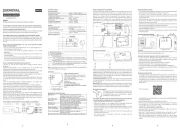
31 Juli 2025
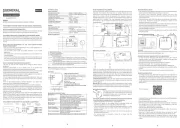
30 Juli 2025
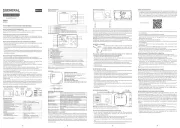
29 Juli 2025
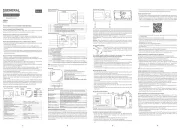
29 Juli 2025
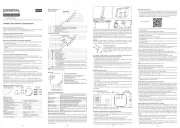
28 Juli 2025
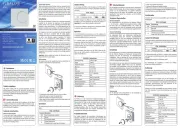
28 Juli 2025
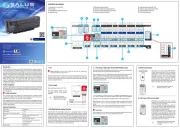
28 Juli 2025
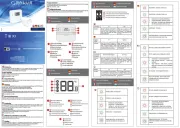
28 Juli 2025
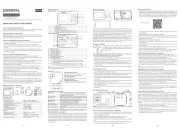
28 Juli 2025
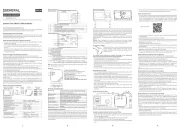
28 Juli 2025